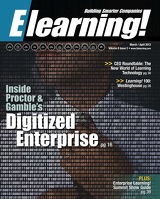Elearning! Magazine: Building Smarter Companies via Learning & Workplace Technologies.
Page 19 of 52
believe you should arrange your store in a certain way to maximize consumer sales. If you have a store that partners with P&G; on this, you can call up the performance standards on your phone, hold it up, look around your store, and compare it with what you see. Eventually, I want to be able to take a picture of the shelf, have it digi- tally compared, and then automatically send action steps back to the retailer to help rearrange the shelf for maximum con- sumer sales. That's where we're going. In fact, some applications like these will
probably come back to the developed world as improvements because they'll be simpler — there's no question that progress will be accelerated by the
ing and simulation, you can go through thousands of iterations in seconds. The key is that you've got to have the data. So the advantage for P&G; is our scale. We have operations in around 80 countries, our products are sold in almost every country, and we touch more than four billion consumers every day. Imagine all those data points. We can literally fit any virtual diaper to any baby anywhere in the world. We're even digitizing the creation of
molecules. For example, in the research and development for our new dishwashing liquid, we used modeling to predict how moisture would excite various fragrance molecules so that throughout the dish-
either negatively or positively, an alarm goes off. Then we can click down and understand what's going on and react to it, because we feel that time compression — or operating in real time — is a competi- tive advantage. Similarly, every Monday morning we
have a meeting with our leadership team all over the world — physically and virtu- ally — where we review the business for the previous week and click down on all this data. And everyone signs up for the principles behind this — it's real time and continuous; it gives us the ability to click down to find causality, make decisions, and then move on. As we apply those principles each week,
P&G; CEO Robert McDonald: 'We hire very good people and train them. The day I joined the company, one of the managers a few levels up said, 'Throw away your MBA textbooks and we'll teach you.' That's still relevant today.'
leapfrogging of technology. Inevitably, everything's got to be usable on the small- est, cheapest device possible because that's what's going to get the broadest distribu- tion in a developing market.
DIGITIZING INNOVATION McDonald: Data modeling, simulation, and other digital tools are reshaping how we innovate. The way we used to do inno- vation research required a lot of work and time setting up consumer panels — you need the right distribution of races, ages, and so forth to make them representative. Now, with the amount of data we have available, the "n" is so large that by defini- tion we can immediately have a represen- tative group. When you design a disposable diaper
the traditional way, for example, by the time you get to the point where you make a prototype, the prototype itself has cost thousands of dollars, if not more, and it was all made by hand. Now, using model-
washing process you get the right fra- grance notes at the right time. We did that all virtually. I think that digital technology will even
help us identify new service components to our consumer products that wouldn't otherwise be immediately obvious. For example, say you're a consumer concerned about the environment. You go to one of our packages and photograph the QR code. We then could download for you all the ingredients in the product and their biodegradability — or tell you where the product was produced, the quality of the water, or how we've reduced carbon emis- sions in the plant. We can't do that today, but it's an aspiration.
IMPROVE DATA AT THE SOURCE McDonald: P&G; employees have a "cockpit" interface on their computers that they help design. It has certain tolerances for the metrics that are important to them. When we go outside those tolerances,
the challenge becomes the data source. I'll use the Philippines again as an example. If a company we buy syndicated data from goes into stores in the Philippines once every two months and does a handheld questionnaire audit, then it doesn't matter if we meet every Monday or not. Our data's not going to be very good. So we've been working with all our data partners to help them understand that our need is for real-time data. For us it's really constraint theory—understanding where the con- straint in our data is and pushing it all the way to the data source. Then, change the data source. For companies like ours that rely on
external data partners, getting the data becomes part of the currency for the rela- tionship. When we do joint business plan- ning with retailers, for example, we have a scorecard, and the algorithm is all about value creation. Getting data becomes a big part of the value for us, and it's a big part of how we work together. We have analytic
Elearning! March / April 2012 19
